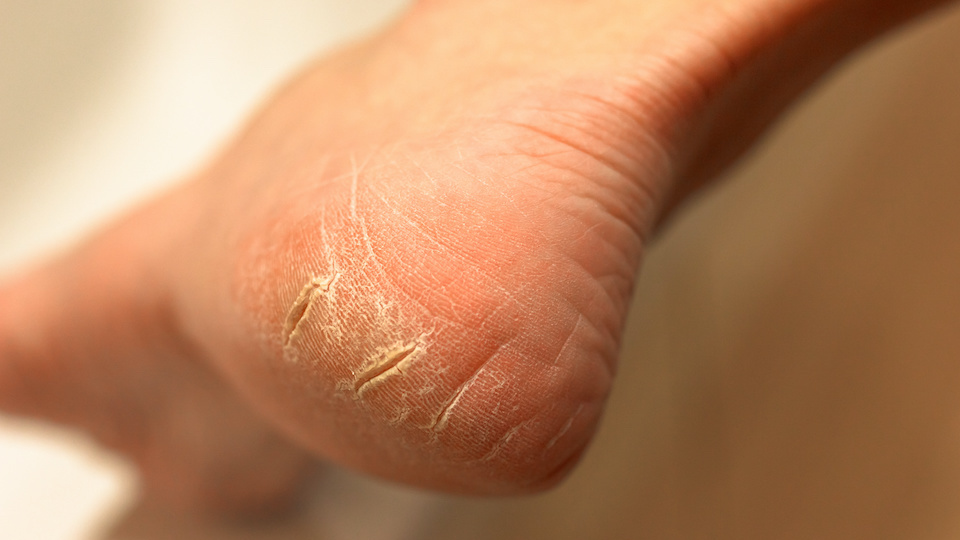When the skin on the bottom of your heels becomes excessively dry, it can crack, leaving painful gaps. Cracked skin worsens in the winter months due to low humidity and cold temperatures — and it seems to afflict more women than men. For some, the condition is uncomfortable but not serious. Yet for others, cracks can worsen over time, and if left untreated, can bleed and lead to serious medical concerns. Here’s what you need to know about cracked heels and what you can do to fix them.
Why are my heels cracking?
Cracked heels, also known as “heel fissures,” are a common foot condition, generally caused by dry skin due to insufficient moisture. Seriously dry feet happen for several reasons, including:
- Not drinking enough water
- Poor nutrition
- Cold weather
- Walking barefoot often
- Natural aging, which can dry skin
- Not using moisturizer on your feet
- Taking hot showers and baths
- Staying too long in the tub — frequently
- Using soaps that are too drying or harsh
- Excessively scrubbing feet
- Diabetes
- Obesity
Cracked heels and infection
Cracks become complicated and more difficult to treat if your skin around the heel begins to thicken and callus. In severe cases, without proper attention and care, your cracked heels could become sore and infected due to bacteria entering the fissures. According to the Institute for Preventive Foot Health (IPFH), if the area becomes red, swollen, and warm to the touch, infection has likely set in. This can be particularly dangerous if you have diabetes.
Sign of diabetes
Dry, cracked heels can also be a sign of something more significant, such as diabetes or autonomic neuropathy, which is the loss of nerve function. A diabetic person might get dry and cracked heels due to nerve damage caused by blood sugar. Unfortunately, people with diabetes are more prone to infection from cracked heels — much more than non-diabetics, according to research. The National Institute of Diabetes and Digestive and Kidney Disease (NIDDK) recommends people with diabetes check their feet daily for symptoms, such as sores, cuts, red spots, calluses, and warm spots.
Cracked heels and obesity
Being overweight is one of the main reasons for heel cracks. Your feet support your entire weight when standing and walking. Even gaining just a few extra pounds could seriously complicate fissures. As your weight increases, your balance and body naturally shift. This creates stresses on your feet and painful conditions like cracked heels. Due to the extra weight, cracks can expand, become sore, bleed, and become infected.
Manuka honey kills pathogens and speeds healing
Many studies have shown that manuka honey can promote wound healing, increase tissue regeneration, and even lessen pain. One study looked at using manuka honey to dress non-healing wounds. The study concluded that 88 percent of the wounds lessened in size when dressed with manuka honey. In addition, manuka honey creates an acidic environment for a wound, which improves healing. Moreover, manuka honey may also help heal the cracks that accompany diabetic foot ulcers. A Greek study found that wounds dressed with manuka honey not only healed faster but also acted as a disinfectant for the wounds in people with diabetic foot fissures.
Studies suggest that Staphylococcus aureus is one of the main and most frequent pathogens to infect diabetic feet. Interestingly, research finds that manuka honey can effectively treat infected wounds caused by antibiotic-resistant strains like Staphylococcus aureus.
How to heal cracked heels naturally with manuka honey
Manuka honey, according to the U.S. Food & Drug Administration (FDA), has been scientifically proven for its antimicrobial and wound healing properties. It’s now being used clinically as a topical treatment for wound infections. Historically, raw honey has always been used around the world for healing burns and skin wounds. In fact, according to research, the ancient Egyptians and Greeks used honey to treat topical skin wounds. When applied to the skin, honey may act as a moisture barrier and provide nutrients and other properties to speed healing. Just apply manuka honey directly to cracked heels, and cover with a dressing.
Soak feet – and exfoliate
Since the skin around cracked heels is thicker and drier, and splits with pressure, soaking your feet, a little exfoliation and moisture can do wonders.
- Soak your feet in a lukewarm, soapy foot bath for at least 20 minutes. Adding apple cider vinegar to the bath can further help relieve dry feet.
- Use a gentle loofah or pumice stone to slough away hard, thick skin. Don’t over scrub, as this will only aggravate the skin and further cause cracking.
- Pat your feet gently to dry.
- Apply a natural heel balm, thick moisturizer, coconut oil (which has anti-inflammatory and antimicrobial properties), or manuka honey to your cracked heels.
- Throw a pair of socks on to hold in the moisture.
To prevent cracked heels, go easy on taking hot showers and baths. Add a little moisture to your feet each morning and night and throw on a pair of socks. However, don’t treat your cracked heels on your own if they’re the result of diabetes. You may need to seek treatment from a foot doctor. Keep in mind, more severe cases of cracked heels should be assessed by a podiatrist — whether you have diabetes or not.
-The UpWellness Team









